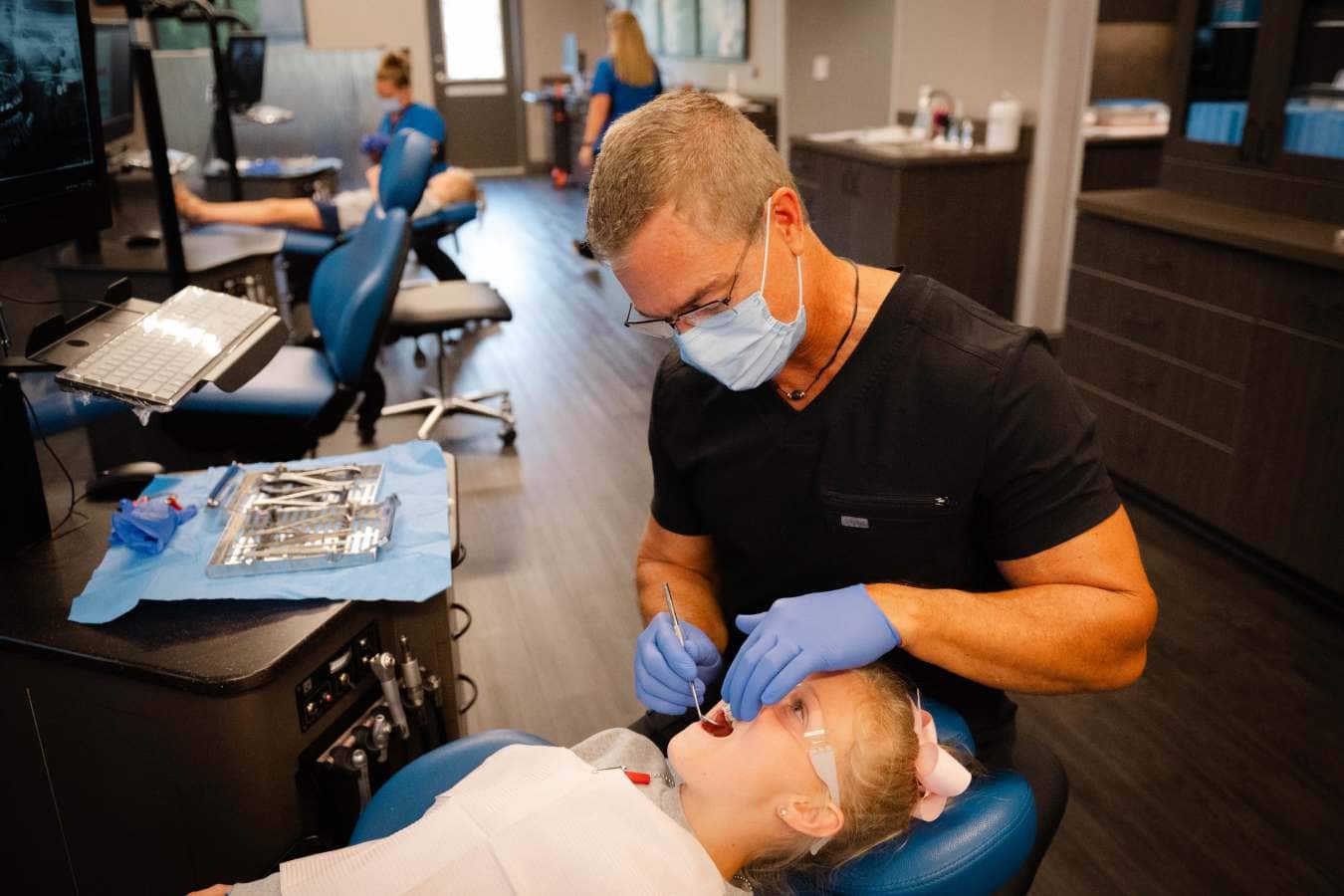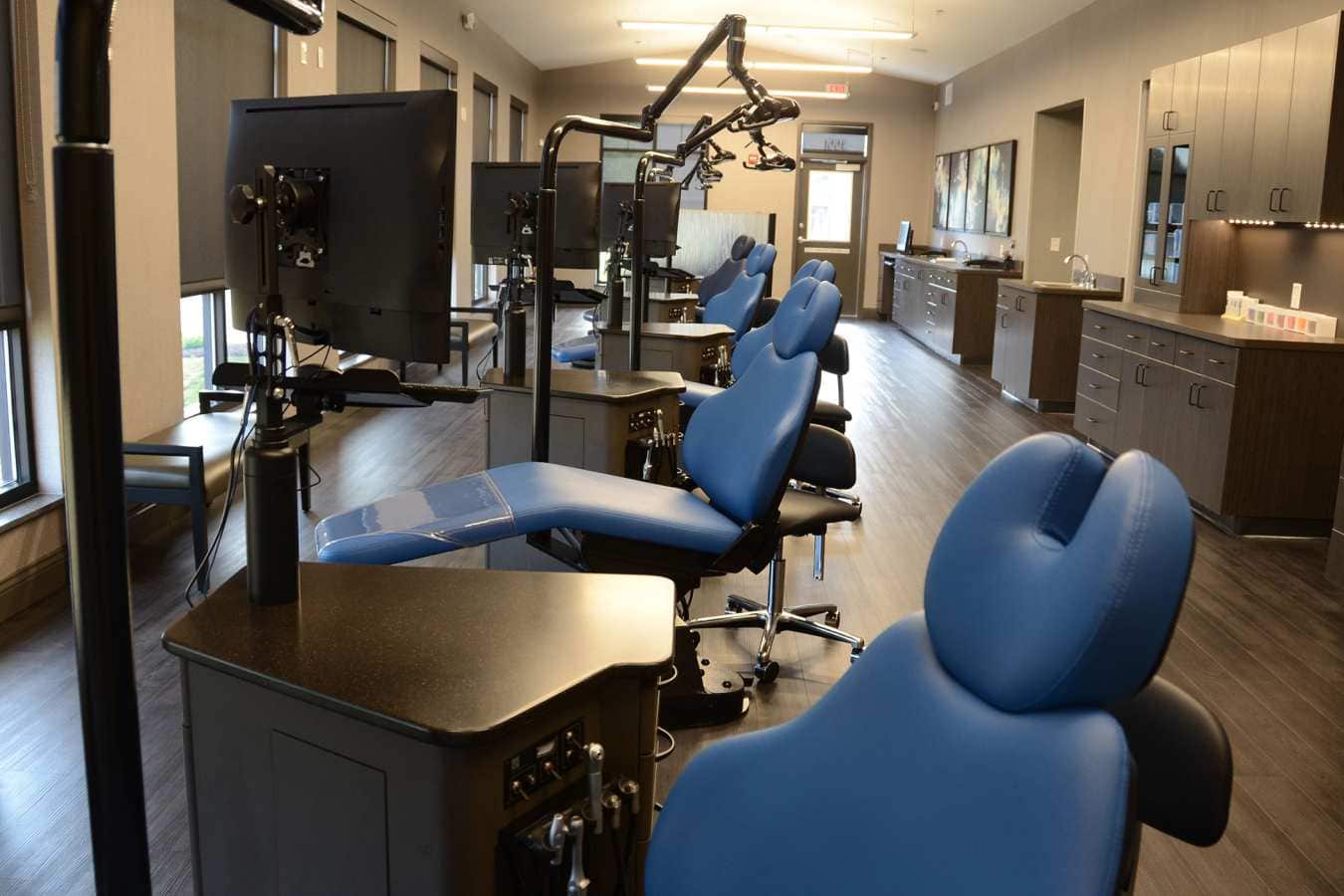Interceptive Orthodontics
At McCabe Orthodontics, we believe in taking a proactive approach to your child’s oral health. This is where interceptive orthodontics comes into play.
Understanding Interceptive Orthodontics
Interceptive orthodontics, also known as early intervention orthodontics, is a preventative treatment that identifies and corrects potential orthodontic issues before they become more serious problems. By addressing these issues early on, we can guide your child’s jaw growth, create space for crowded teeth, avoid the need for tooth extractions, and prevent future orthodontic treatment.
When Should Your Child See an Orthodontist?
The American Association of Orthodontists recommends that children have their first orthodontic evaluation by the age of seven. At this age, most children have a mix of baby teeth and permanent teeth, making it easier for Dr. Russell McCabe to diagnose and correct tooth and jaw problems sooner.

Benefits of Interceptive Orthodontics
Interceptive orthodontics offers several benefits:
- Preventing Future Problems — Early treatment can prevent more serious problems from developing and may make treatment at a later age shorter and less complicated.
- Guiding Jaw Growth — We can influence jaw growth to help facial symmetry.
- Reducing Risk Of Trauma — Protruding front teeth are more susceptible to injury. Early correction can reduce the risk.
- Creating Space — We can create room for crowded, erupting teeth, reducing the need for extractions.
The McCabe Orthodontics Commitment
At McCabe Orthodontics, we’re committed to providing your child with the highest quality care in a friendly, comfortable environment. Our team is experienced in interceptive orthodontics and will work closely with you and your child to develop a personalized treatment plan.
If you think your child might benefit from interceptive orthodontics, contact our office today to request a free consultation. We’re here to help guide your child’s oral health journey, setting them up for a lifetime of beautiful smiles.

Types of Appliances
Elastics (Rubber Bands)
Wearing elastics (or rubber bands) improves the fit of your upper and lower teeth. Wear rubber bands as instructed, and remember that the rubber bands work far more efficiently if they’re worn as prescribed.
Carrier® Distalizer™ Appliance
Creating a Corrected Bite Without Headgear
The Carriere Distalizer is an orthodontic device developed to correct a bite without removing permanent teeth when teeth have erupted incorrectly. With an effect similar to headgear, but without the use of a bulky appliance, the Carriere Distalizer pushes upper teeth back to create a corrected bite prior to the addition of braces. How does the Carriere Distalizer work?
- First, your orthodontist will create an anchor point, most commonly with a lower Essex Appliance, a passive lingual arch, a full mandibular fixed appliance, or mini-screws. A Carriere Distalizer arm is then attached to the upper teeth on both sides of your mouth.
- An elastic band is attached from the upper bar to the lower back molars and should be worn at all times except when eating.
- With good elastic wear, your bite can be corrected in a matter of months, depending on the severity of your case.
- When the Carriere Distalizer arms are removed, we will place upper braces to finish correcting your bite and aligning your teeth to the perfectly straight, ideal smile you’ve always wanted.
MARA Appliance
The MARA (Mandibular Anterior Repositioning Appliance) is used to help the lower jaw develop in a forward direction. This eventually leads to an ideal bite. The upper and lower parts of the MARA appliance are bonded to your child’s molars. It also includes a connection between the upper and lower. By adjusting the connection, Dr. McCabe is able to control the lower jaw’s position in relation to the upper teeth. The typical treatment time with a MARA appliance is 12 months. Braces can be worn before, during, or after the MARA use.
Palatal Expander
The palatal expander “expands” (or widens) your upper jaw by putting gentle pressure on your upper molars each time an adjustment is made. Your orthodontist will instruct you about when and how to adjust your expander. When you achieve the desired expansion, you will wear the appliance for several months to solidify the expansion and to prevent regression.
Positioners
Positioners complete the final tooth movements in your orthodontic treatment. With your full cooperation, you should only need to wear the positioner appliance for four to eight weeks.
Retainers
Retainers may be removable or fixed. They hold your teeth in their new, correct positions after your teeth have been straightened. Your orthodontist will instruct you on how to care for your retainer and about the duration of the wear. Wearing your retainer as directed is crucial to prevent regression of your treatment.
Separators or Spacers
Separators are little rubber doughnuts that may be placed between your teeth to push them apart so that orthodontic bands may be placed during your next appointment. The separators will be removed before we place the bands. Separators do not mix well with sticky foods, toothpicks, or floss.

Retainer Care
- Wear your retainer at all times, until the doctor instructs otherwise.
- Take your retainer out when eating, and always put it back in its case! (Most appliances are lost in school lunchrooms or restaurants.)
- Clean the retainer thoroughly once a day with a toothbrush and toothpaste. Use warm but not hot water. Brushing retainers removes the plaque, and eliminates odors. Efferdent® or other orthodontic appliance cleaners can be used but do not take the place of brushing.
- When your retainer is not in your mouth, it should ALWAYS be in its case. Pets love to chew on them!
- Initially, you may find it difficult to speak. Practice speaking, reading, or singing out loud to get used to it faster.
- Retainers are breakable, so treat yours with care. If your retainer gets lost or broken, call us immediately.
- If you have any questions or concerns about your retainer, or you believe it needs adjusting, call us. Do not try to adjust it yourself.
- Always bring your retainer to your appointments.
- Retainer replacements are expensive, but with proper care they will last for years!
- Remove your retainer when you go swimming.
- Keep retainers away from hot water, hot car dashboards, pockets, the washing machine, and napkins.
Emergency Orthodontics
True orthodontic emergencies are rare, but when they occur we are available to you. As a general rule, you should call our office when you experience severe pain or have a painful appliance problem you can’t take care of yourself. We’ll be able to schedule an appointment to resolve the problem.
You might be surprised to learn that you may be able to solve many problems yourself temporarily until you can get to our office. If there is a loose piece that you can remove, put it in a plastic bag or envelope and bring it with you to your next appointment. If your braces are poking you, put soft wax on the piece that’s sticking out. If the wire has slid to one side, you can pull it back to the other side with needle-nosed pliers, replacing it in the tube on the back tooth.
After alleviating your discomfort, it is very important that you still call our office as soon as possible to schedule a time to repair the problem. Allowing your appliance to remain damaged for an extended period of time may result in disruptions to your treatment plan.
General Soreness
When you get your braces on, you may feel general soreness in your mouth, and teeth may be tender to biting pressures for three to five days. Stick to a soft diet until your teeth do not hurt to chew. Irritated gums and other sore spots can be relieved by rinsing your mouth with a warm salt-water mouthwash. Dissolve one teaspoonful of salt in eight ounces of warm water, and rinse your mouth vigorously. If the tenderness is severe, take Acetaminophen (Tylenol) or whatever you normally take for headache or similar pain. Aspirin, Ibuprofen (Motrin, Advil), and Naproxen Sodium (Naprosyn, Anaprox) actually slow tooth movement, so it is not advisable to use them frequently while wearing braces.
The lips, cheeks, and tongue may become irritated for one to two weeks as they learn a new posture and become accustomed to the surface of the braces. You can put wax on the braces to lessen this. We’ll show you how!
Headgear
Sometimes discomfort is caused by not wearing the headgear as instructed by your orthodontist. Please refer to the instructions provided by your orthodontist. If the facebow (metal piece) is bent, please call our office for assistance. The headgear should hurt less the more it’s worn, so be sure you get in the prescribed number of hours.
Loose Appliance
If your appliance is poking you, place wax on the offending part.
Loose Bracket
If your bracket or band is still attached to the wire, you should leave it in place and put wax on it if needed for comfort. If the bracket or band can be removed easily, place it in an envelope and save it to bring to your next appointment.
Loose Wire
Using a pair of tweezers or needle-nosed pliers, try to put your wire back into place. It is okay to use a piece of floss to tie the wire into place: tie the floss around the bracket in place of the missing colored o-ring. If you cannot put the wire into a comfortable position, and covering the end with wax doesn’t help, as a last resort use a small fingernail clipper to clip the wire behind the last tooth to which it is securely fastened. If the end of the wire is still sharp place wax on it.
Poking Wire
Using a pencil eraser, push the poking wire down or place wax on it so that it is no longer poking.